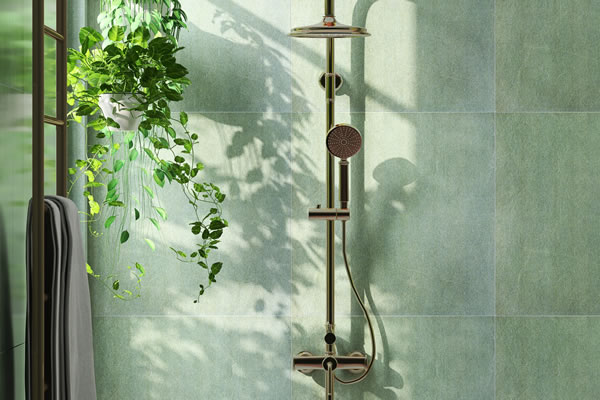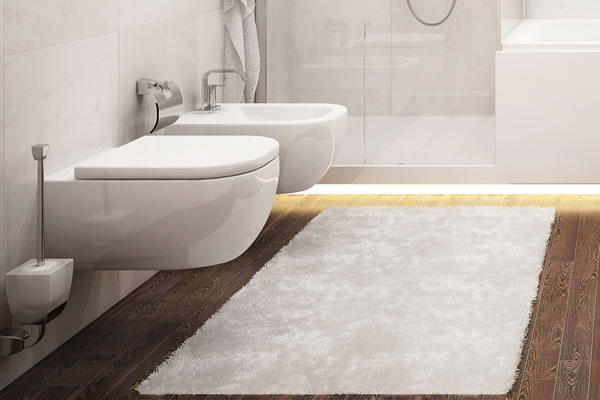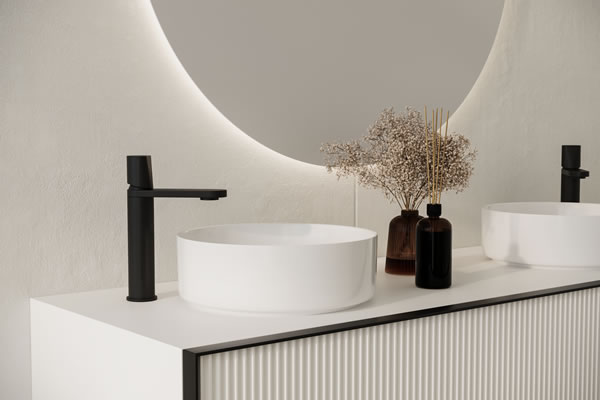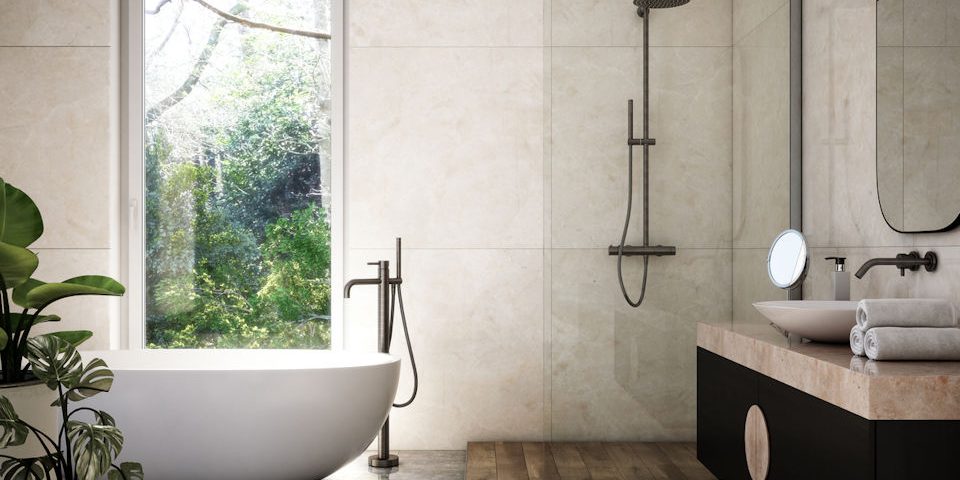Luxury and Bespoke Bathroom Fixtures
Your new luxury bathroom can add at least 5% to your property’s value. However, a well-designed, professional bathroom install can add even more. As experienced plumbers serving Reading and the surrounding areas, we’ve seen firsthand how the right luxury fixtures can completely transform both the functionality and value of your home.
Luxury bathroom fixtures, like free-standing bathtubs, walk-in showers or wet rooms, and stone basins last longer. They’re also more user-friendly, enjoyable, and easier to keep clean. But choosing the right fixtures isn’t just about picking the most expensive options – it’s about understanding what makes a fixture truly luxurious and how it fits into your lifestyle.
Luxury Bath Tubs
What Makes Them Worth The Investment
When most people think “luxury bathtub,” they picture something massive and expensive. But here’s the thing – size and price don’t automatically equal luxury.
I’ve seen plenty of oversized acrylic tubs that look impressive in the showroom but feel cheap the moment you touch them.
Real luxury in bathtubs comes down to three things:
…Materials, Craftsmanship, and How They Are Installed.

Materials That Matter
The difference between a standard tub and a luxury one starts with what it’s made from. Your typical high-street bathtub is usually acrylic or fibreglass – lightweight, affordable, but they lose heat faster than you can say “cold bath.”
Luxury tubs use materials like cast iron, natural stone, or high-grade composites. Cast iron might seem old-fashioned, but there’s a reason Victorian-era tubs are still going strong after 150 years. They hold heat brilliantly and feel solid under you – no flexing or creaking when you settle in.
Stone resin tubs are gaining popularity for their substantial feel and heat retention, which eliminates the weight issues associated with cast iron. Copper tubs are another option – they look stunning and actually have antibacterial properties, though they need a bit more care to keep them looking their best.
The Feel Factor
Here’s what separates luxury from standard: when you run your hand along the edge of a quality tub, it feels smooth and substantial. The walls are thick enough that they don’t flex when you lean against them. The overflow and waste fittings are properly integrated, not just stuck on as an afterthought.
Luxury tubs also tend to have better ergonomics. The shape is designed for actual human bodies, not just to look good in photos. You should be able to lie back comfortably without sliding around or having the tap digging into your back.
Installation Considerations
One thing people often overlook is that luxury tubs require more than just replacing your old one. Cast iron and stone tubs are heavy, really heavy. Your floor might need reinforcing, especially if you’re on an upper floor.
The plumbing requirements can be different, too. Some luxury tubs have deeper capacities or unique drain configurations. It’s worth having a proper assessment done before you fall in love with something that won’t work in your space.
Worth the Investment?
A quality luxury tub isn’t just about having something that looks impressive. It’s about having something that will still be working perfectly in 20 years, that holds its heat so you can enjoy a proper soak, and that adds genuine value to your home.
The key is choosing something that fits your space, your budget, and how you live.
There’s no point having the most beautiful tub in the world if it doesn’t work for your daily routine.
Luxury Bathroom Showers:
Beyond the Basic Rinse
Most people think a luxury shower just means a bigger showerhead or fancier tiles. But walk into a proper luxury shower and you’ll immediately feel the difference – it’s about the entire experience, not just one flashy component.
A proper luxury shower system is designed around comfort, consistency, and control. It’s the difference between a quick rinse to get clean and looking forward to your daily shower.

What Makes a Shower “Luxury”
The heart of any luxury shower is the valve system. This isn’t the bit you see – it’s hidden behind the wall, controlling water temperature and pressure. Standard mixer showers can leave you dancing around trying to find the right temperature, or worse, getting scalded when someone runs a tap elsewhere in the house.
Luxury showers use thermostatic valves that maintain your exact temperature setting regardless of pressure changes. Set it once, and it stays there. Some systems go further with digital controls that remember your preferences and can even preheat the water before you step in.
The showerheads themselves are where you notice the difference.
Rainfall heads create that spa-like experience, but they need proper water pressure to work effectively. Body jets can turn your shower into a massage experience, though positioning is crucial – what feels great for one person might be uncomfortable for another.
Materials and Build Quality
Luxury shower components use solid brass bodies with thick chrome or brushed finishes that won’t chip or tarnish over time. The internal mechanisms are built to last decades, not just the warranty period.
You’ll also notice the weight difference. Quality shower heads and controls feel substantial in your hand. The levers move smoothly without any play or wobble, and everything fits together precisely without gaps or misalignment.
Design Considerations
Size matters, but not in the way most people think. A well-designed compact shower with quality fittings will feel more luxurious than a massive space with poor water pressure and cheap fixtures.
Wet rooms offer the ultimate luxury shower experience – no doors, no screens, just an open space where everything is waterproofed. But they’re not suitable for every home and require expert installation to prevent water damage.
Glass enclosures in luxury showers use thicker panels with better sealing systems. The hardware is typically stainless steel or brass rather than plastic, and the doors glide smoothly rather than sticking or rattling.
Water Pressure and Supply
Here’s something many people overlook: luxury shower systems often need more water pressure and flow than standard setups. Multiple body jets, large rainfall heads, and steam functions all demand an adequate supply.
If your home has low pressure, you might need a pump system installed. It’s better to address this during planning rather than discovering your dream shower system doesn’t work correctly after installation.
Installation Reality Check
Luxury showers require more than just swapping out your old unit. The plumbing behind the wall often needs upgrading to handle increased flow rates. Electrical work might be needed for pumps, digital controls, or lighting systems.
Proper waterproofing becomes even more critical with luxury installations. More water flow means more potential for damage if something goes wrong. The tanking and sealing work needs to be absolutely spot-on.
Steam and Additional Features
Steam showers are becoming more popular, turning your daily routine into a spa experience. But they need proper ventilation, electrical supply, and regular maintenance to prevent mold and mechanical issues.
Chromotherapy lighting, built-in speakers, and aromatherapy systems can enhance the experience, but they also add complexity. More components mean more potential maintenance requirements down the line.
Making the Right Choice
The best luxury shower system is one that matches how you live.
If you’re always rushing in the morning, focus on systems that heat up quickly and provide consistent pressure. If you prefer long, relaxing showers, invest in features that enhance that experience.
Consider who else will be using the shower. Systems with multiple user presets work well for families, while simpler luxury setups might be perfect for guest bathrooms.
Remember that installation quality is just as important as the components themselves. The most expensive shower system won’t perform properly if the groundwork isn’t done correctly.
Luxury Bathroom Toilets:
More Than Just a Pretty Seat
When you’re spending money on a luxury bathroom, you don’t want to cheap out on the one fixture you’ll use most often.
The thing is, most people don’t really know what makes a toilet “luxury” beyond a higher price tag.
They see something sleek in the showroom and assume it’s better. But there’s quite a bit of engineering that goes into a proper quality toilet.

What You’re Actually Paying For
A decent toilet should flush properly every single time without you having to hold the handle down or give it a second go. Sounds basic, but you’d be surprised how many expensive-looking toilets fail this simple test.
Luxury toilets use better flushing mechanisms, usually dual-flush systems that give you options for different waste types. The internal components are built to last. Cheaper toilets often have plastic parts that warp or break within a few years. Quality ones use brass and stainless steel components that keep working correctly.
The bowl design matters too. Better toilets have glazing that goes all the way around, making them easier to keep clean. The trap way (the bit you can’t see) is larger and smoother, which means fewer blockages and better waste removal.
Wall-Hung vs Floor-Standing
Wall-hung toilets look modern and make cleaning the floor much easier since there’s no base to work around. But they’re not just a case of hanging something on the wall – they need a proper frame system built into the wall structure, and the cistern gets hidden behind the tiles.
This looks clean and minimalist, but if something goes wrong with the mechanism, you’re potentially looking at opening up the wall to fix it. Make sure there’s proper access planned during installation.
Floor-standing toilets are more traditional but often more practical for maintenance. Close-coupled designs (where the cistern sits directly on the pan) are the most common, but back-to-wall models give you a cleaner look while keeping everything accessible.
Smart Features That Actually Work
Heated seats aren’t just a luxury – they’re genuinely helpful, especially in colder months. Automatic lid opening and closing is handy when your hands are full. Built-in bidets are becoming more popular and can be particularly helpful for senior users or anyone with mobility issues.
Some toilets now have night lights, automatic flushing, and even air freshening systems. These features can be helpful, but remember that more electronics mean more potential maintenance issues down the line.
Comfort Height and Accessibility
Standard toilets are designed for the average height of decades ago. Comfort height toilets (about 2-3 inches taller) are easier for most adults to use and particularly helpful for anyone with knee or back problems.
The seat quality makes a difference, too. Soft-close hinges prevent slamming and last longer than plastic hinges. Quick-release seats make cleaning much easier.
Installation Considerations
Even the best toilet won’t work properly if the waste pipe isn’t positioned correctly or if the floor isn’t level. Some luxury toilets have specific requirements for water pressure or electrical supply (for heated seats or smart features).
The rough-in measurement (distance from wall to waste pipe centre) needs to match your existing setup, or you’ll need additional work to make it fit. Most UK toilets use a standard measurement, but it’s worth checking before ordering.
Water Efficiency
Modern luxury toilets often use less water than older standard models while performing better. Dual-flush systems typically use 3-4 litres for liquid waste and 6 litres for solid waste, compared to older toilets that used 9-13 litres every time.
Some high-end models use pressure-assisted flushing or other technologies to get better performance with even less water. Good for the environment and your water bill.
What to Avoid
Avoid toilets with too many complicated features unless you’re prepared for potential maintenance issues. Simple, well-built mechanisms tend to be more reliable long-term.
Don’t choose a toilet based purely on looks – comfort and functionality should come first. A beautiful toilet that’s uncomfortable to use or doesn’t flush properly isn’t worth having.
Getting It Right
The best luxury toilet is one that works reliably, feels comfortable, and fits your space properly. It should be easy to keep clean and not require constant maintenance.
Consider how the toilet will be used and by whom. A guest toilet might benefit from automatic features, while a family bathroom might prioritise durability and easy cleaning.
Remember that installation quality matters just as much as the toilet itself. Even the most expensive model won’t perform well if it’s not fitted correctly.
Luxury Bathroom Basins:
The Centrepiece of Your Bathroom
Luxury Bathroom Basins
Your basin gets more daily use than any other fixture in your bathroom, so it makes sense to invest in something that’ll stand up to constant use while looking good doing it.
But here’s what most people get wrong about luxury basins – they focus entirely on how it looks and forget about how it actually works day-to-day.
A stunning basin that’s a pain to use or impossible to keep clean isn’t luxury, it’s just expensive frustration.

What Makes a Basin Worth the Money
Quality basins are made from materials that can handle daily abuse without showing wear. Cheap ceramic basins often have thin glazing that chips easily or develops hairline cracks over time. Proper luxury basins use thicker ceramic with glazing that goes deep into the material.
Natural stone basins look incredible but need regular maintenance.
Marble and granite are porous, so they’ll stain if you spill coffee or wine and don’t clean it up immediately. They also need sealing every year or two to keep them looking their best.
Solid surface materials like Corian can be shaped into almost any design and repaired if damaged. Scratches can be sanded out rather than living with them forever. They’re non-porous too, so staining isn’t usually an issue.
Vessel vs Undermount vs Integrated
Vessel basins sit on top of your counter and can look dramatic, but they’re not always practical. Water splashes onto the surrounding surface every time you use them. Cleaning around the base becomes tedious, and you need to think about tap height – too low and you can’t get your hands under properly, too high and water splashes everywhere.
Undermount basins give you clean lines and make counter cleaning easy since there’s no rim to work around. But they need proper support underneath and professional installation to prevent sagging or detachment over time.
Integrated basins, where the basin and counter are one piece, eliminate all the cleaning hassles around joints and edges. No gaps for dirt to collect, no sealing to maintain. The downside is that damage to either part means replacing the whole unit.
Size and Shape Reality
Bigger isn’t always better with basins. A massive basin might look impressive, but if it takes up all your counter space, you’ve got nowhere to put your toothbrush or soap dispenser.
Deep basins can be great for washing hair or soaking items, but they can also be awkward for everyday use like brushing teeth or washing hands. You want something that works for how you actually use your bathroom.
Round basins often look elegant but give you less usable space than rectangular ones of the same width. Square basins maximize space but can be harder to clean in the corners.
Tap Compatibility
This is where people often trip up. Not every tap works with every basin. Vessel basins need taller taps, but too tall and you get splash-back. Wall-mounted taps look clean but need to be positioned precisely during installation – get it wrong and the water doesn’t hit the basin properly.
Single-lever mixers are convenient for daily use, but traditional pillar taps might suit your home’s style better. Whatever you choose, make sure the internal components are quality – cheap cartridges in expensive taps are a false economy.
Overflow and Waste Considerations
Some luxury basins don’t have overflows, which gives a cleaner look but means you need to pay attention when filling them. Others have hidden overflows that work but aren’t visible from above.
The waste fitting matters too. Pop-up wastes look neat but can be fiddly to operate and harder to clean than simple plug and chain systems. Click-clack wastes are a good middle ground – easy to use and maintain.
Installation Requirements
Heavy stone basins need proper support, especially if you’re going with an undermount installation. The counter material and fixings need to be able to handle the weight when the basin is full of water.
Some luxury basins have specific plumbing requirements. Wall-hung basins need the waste and supply pipes positioned precisely, and the wall needs to be strong enough to support the weight.
Maintenance Reality
Think about cleaning before you buy. Textured surfaces might look interesting but collect dirt and soap scum. Very dark colors show water spots and soap residue more than lighter shades.
Natural stone needs different cleaning products than ceramic or solid surface materials. Some cleaning chemicals can actually damage certain basin materials, so you need to know what you’re working with.
Getting the Balance Right
The best luxury basin is one that looks good, works well for your daily routine, and fits your space properly. It should be easy to keep clean and not require constant maintenance to look its best.
Consider who else will be using it. A basin that works perfectly for adults might be too high or awkward for children to use comfortably.
Remember that the basin is just one part of the equation. The taps, counter, and surrounding fixtures all need to work together to create a truly luxurious experience.
Bathroom Design and Installations
Choosing WSC Plumbing to design and install your luxury bathroom means no headaches. Because we only use the best suppliers to avoid supplier problems found in the budget and mid-range bathroom market.
Find out more about Bathroom Installers and our bathroom installation services.







